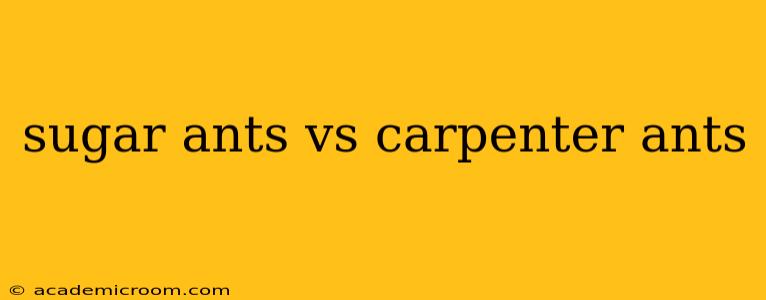Ants are a common household nuisance, but not all ants are created equal. Two species frequently invade homes are sugar ants and carpenter ants, each posing different threats and requiring different control strategies. This comprehensive guide will delve into the key differences between sugar ants and carpenter ants, helping you identify the invaders and effectively address the infestation.
What are Sugar Ants?
Sugar ants, also known as odorous house ants ( Tapinoma sessile), are small, dark brown or black ants typically measuring about 1/16 to 1/8 inch long. They are attracted to sweet substances, hence their name, and often leave a characteristic musty or rotten coconut odor when crushed. These ants are not known for causing structural damage, unlike their carpenter ant cousins. Their nests are usually found outdoors, but they readily invade homes in search of food.
What are Carpenter Ants?
Carpenter ants (Camponotus species) are significantly larger than sugar ants, ranging from 1/4 to 1/2 inch long. They are black, red, or a combination of both colors. Unlike sugar ants, carpenter ants don't primarily feed on sweets; their diet is more diverse, including insects, honeydew, and other protein sources. However, they are renowned for their wood-nesting habits, excavating galleries within wood structures, leading to potential structural damage. This is a key distinction that makes identifying them crucial for home maintenance.
How to Tell Sugar Ants and Carpenter Ants Apart: A Side-by-Side Comparison
| Feature | Sugar Ants (Odorous House Ants) | Carpenter Ants |
|---|---|---|
| Size | 1/16 to 1/8 inch | 1/4 to 1/2 inch |
| Color | Dark brown or black | Black, red, or black and red |
| Odor | Musty or rotten coconut odor | Usually no distinct odor |
| Diet | Sweet substances | Insects, honeydew, other protein sources |
| Nesting | Outdoors, but readily invade homes | Primarily within wood, causing structural damage |
| Damage | Minimal to none | Can cause significant structural damage |
What are the signs of a sugar ant infestation?
Finding trails of sugar ants leading to food sources, such as crumbs on the counter or spills on the floor, is a clear indication of an infestation. You may also notice them scavenging for food in garbage cans or pet food bowls. Their small size means they can easily squeeze into even tiny cracks and crevices in your home.
What are the signs of a carpenter ant infestation?
Signs of a carpenter ant infestation are more significant and often involve structural damage. You might find:
- Sawdust-like frass: This is the debris created as carpenter ants tunnel through wood.
- Hollow-sounding wood: Tapping on suspected areas can reveal hollow spots where ants have excavated galleries.
- Ants themselves: Their larger size makes them easier to spot than sugar ants.
- Flights of winged reproductive ants (swarmers): This is a common sign of an established colony.
How do I get rid of sugar ants?
Control of sugar ants usually involves identifying and eliminating food sources. Thorough cleaning, proper food storage, and using ant baits can effectively eliminate infestations. Ant baits are particularly effective as ants carry the bait back to the colony, leading to its demise.
How do I get rid of carpenter ants?
Carpenter ant infestations require a more comprehensive approach. Since they nest within wood, simply eliminating food sources isn't enough. Professional pest control is often recommended to properly identify the extent of the infestation, locate the nests, and apply appropriate treatments. DIY attempts may only address surface-level problems.
What attracts sugar ants to my house?
Sugar ants are primarily attracted to food and water sources. Any spills, crumbs, or standing water can entice them inside.
What attracts carpenter ants to my house?
Carpenter ants are attracted to moist, decaying wood. Leaks, poorly ventilated areas, and wood damaged by water are all potential entry points and nesting sites.
Can I get rid of ants myself, or should I call a professional?
For minor sugar ant infestations, DIY methods are often successful. However, carpenter ant infestations and extensive sugar ant problems should be handled by a professional pest control service. Professionals possess the expertise and tools to effectively eliminate the colony and prevent future infestations, especially regarding the potential structural damage caused by carpenter ants. They can accurately assess the situation and implement a targeted treatment strategy.
